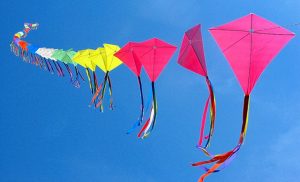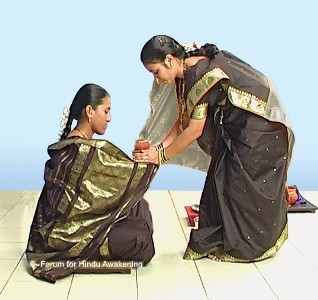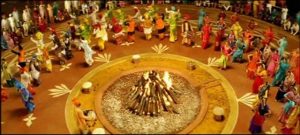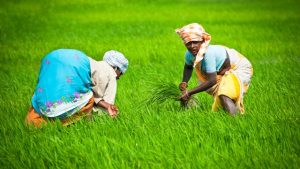Makar Sankranti is the festival of virtues and religion Sankranti literally means “movement.” Our life is full of movements; even in the Mother Nature, everything is moving. Everything that we recognize as life is movement. The planet is moving and that is why it stirs up life. Movement is pleasant if it does not disturb us. The planet earth is moving gently changing seasons.
Makar Sankranti marks the transition of t he Sun into the zodiac sign of Capricon (Makara rashi) on its celestial path. The day signifies arrival of spring. Makara Sankranthi is a solar event making one of the few Indian festivals which fall on the same date in the Gregorian calendar every year i.e on 14 January, with some exceptions sometimes this festival is celebrated on 13 or 15 January. Makara Sankranti begins the harvest season and ends the northeast monsoon in South India. Apart from a harvest festival Sankranti is also regarded as the beginning of an auspicious phase in Indian culture. This festival is regarded as a ‘holy phase of transition’. It marks the end of an inauspicious phase which according to the Hindu calendar begins around mid-December. From Makar Sankranti any auspicious and sacred ritual is sanctified in a Hindu family. Scientifically, this day marks the beginning of warmer and longer days compared to the nights. In other words, Sankranti marks the termination of winter season and beginning of a new harvest or spring season.
he Sun into the zodiac sign of Capricon (Makara rashi) on its celestial path. The day signifies arrival of spring. Makara Sankranthi is a solar event making one of the few Indian festivals which fall on the same date in the Gregorian calendar every year i.e on 14 January, with some exceptions sometimes this festival is celebrated on 13 or 15 January. Makara Sankranti begins the harvest season and ends the northeast monsoon in South India. Apart from a harvest festival Sankranti is also regarded as the beginning of an auspicious phase in Indian culture. This festival is regarded as a ‘holy phase of transition’. It marks the end of an inauspicious phase which according to the Hindu calendar begins around mid-December. From Makar Sankranti any auspicious and sacred ritual is sanctified in a Hindu family. Scientifically, this day marks the beginning of warmer and longer days compared to the nights. In other words, Sankranti marks the termination of winter season and beginning of a new harvest or spring season.
Makar Sankranti is celebrated in Karnataka by exchanging pieces of sugarcane, a mixture of fried til (sesame), molasses, and pieces of dry coconut, peanuts and fried gram. On this auspicious day, people in Karnataka distribute Yellu and bella (Sesame seeds and Jaggery) and greet with the words” Ellu bella thindu, Olle Maathu Aadu” (Eat sesame seeds and speak only well). The significance of this exchange is that sweetness should win through in all the dealings.
In Tamilnadu it is celebrated as one of the major festivals. It is celebrated over four days. The festivities begin on the last day of the 9th Tamil month of “Maargazhi” and continue till the third day of the 10th Tamil month 0f “Thai“. It marks a new beginning; as, during the month of Maargazhi people abstain from all family celebrations and spend the entire month for devotion. On the day of Sankranti cows and bullocks are attractively decorated and fed ‘Pongal’- a sweet preparation of rice. Special prayers are offered. In the evening, the cattle are led out in procession to the beat of drums and music. A festival called Jalli kathu is held in Madurai, Tiruchirapalli and Tanjavur,all in Tamil Nadu, on this day. Bundles of money are tied to the horns of fierce bulls which the villagers try to repossess. Everyone joins in the community meal, at which the food is made of the freshly harvested grain. This day is named and celebrated as Tamilian Tirunal in a fitting manner throughout Tamil Nadu.
In Kerala, at Sabarimala where the Makara Jyothi is visible followed by the Makara Vilakku celebrations. The 40 days anushthana by the devotees of Ayyappa ends on this day in Sabarimala with a big festival.
 In Maharashtra, Sankranti is celebrated by exchanging multi-colored tilguls made from til (sesame seeds) and sugar and til-laddus made from til and jaggery. Since sesame seeds have a greater ability to absorb and emit sattva(virtues) frequencies, consuming tilgul helps improve spiritual practice. People exchange tilgul amongst one another results in an exchange of sattvic component. Gul-poli is offered for lunch. And, while exchanging tilguls as tokens of goodwill people greet each other saying”til-gul ghya, goad goad bola” meaning “accept these tilguls and speak sweet words”. The primary thought in the exchange of tilguls is to forget the past ill-feelings and conflicts and resolve to speak sweetly and remain friends. Women folk invite other married women for a get-together called “Haldi-Kumkum” and given gifts (utensil, clothes, etc.). Women wear black sarees on this occasion. In Goa, celebrations closely resemble that in Maharashtra; the women folk celebrate ‘haldi-kumkum’.
In Maharashtra, Sankranti is celebrated by exchanging multi-colored tilguls made from til (sesame seeds) and sugar and til-laddus made from til and jaggery. Since sesame seeds have a greater ability to absorb and emit sattva(virtues) frequencies, consuming tilgul helps improve spiritual practice. People exchange tilgul amongst one another results in an exchange of sattvic component. Gul-poli is offered for lunch. And, while exchanging tilguls as tokens of goodwill people greet each other saying”til-gul ghya, goad goad bola” meaning “accept these tilguls and speak sweet words”. The primary thought in the exchange of tilguls is to forget the past ill-feelings and conflicts and resolve to speak sweetly and remain friends. Women folk invite other married women for a get-together called “Haldi-Kumkum” and given gifts (utensil, clothes, etc.). Women wear black sarees on this occasion. In Goa, celebrations closely resemble that in Maharashtra; the women folk celebrate ‘haldi-kumkum’.
In Gujarat, Sankrant is celebrated with lot of fun and frolic. People offer thousands of colorful offerings to the Sun in the form of beautiful kites. The act stands as a symbol for reaching to their beloved God, the one who represents the best. This festival thus helps the maintenance of social relationships within the family, caste and community. Kite flying has been associated with this festival in a big way. It has become an internationally well-known event.
 In Punjab where December and January are the coldest months of the year, huge bonfires are lit on the eve before Sankranti and are celebrated as Lohri. Sweets, sugarcane and rice are thrown in the bonfires, around which friends and relatives gather together. The following day, which is Sankrant, is celebrated as Magi. The Punjabi’s dance their famous dance Bhangra, and then gather to enjoy sumptuous food that is specially prepared for the occasion.
In Punjab where December and January are the coldest months of the year, huge bonfires are lit on the eve before Sankranti and are celebrated as Lohri. Sweets, sugarcane and rice are thrown in the bonfires, around which friends and relatives gather together. The following day, which is Sankrant, is celebrated as Magi. The Punjabi’s dance their famous dance Bhangra, and then gather to enjoy sumptuous food that is specially prepared for the occasion.
In Bundelkhand and Madhya Pradesh this festival of Sankrant is known by the name “Sakarat” and is celebrated with great pomp & high spirits accompanied by a lot of sweets.
In Orissa, many tribes start their New Year from the day of Sankranti by lighting bonfires, dancing and eating their particular dishes sitting together. The Bhuya tribals of Orissa have their Maghyatra in which small home-made articles are put for sale. In Jagannath temple at puri this festival is observed as Uttarayana Yatra and Uttarayan Vandapana of lord Jagannath. People offer a special kind of newly harvested rice and sugarcane mixed with jaggery, grated coconut, banana, molasses, chenna (cheese), Khua, various fruits, dry fruits and milk called “Makara Chaula” to the presiding deity, the Sun God & lit solemn pyre for satisfying the evil elements plaguing household. This day is also observed in Jagannath temple, Puri with two popular Veshas (costumes) of Lord Jagannath i.e. Nabanka Vesha (one day before Makar Sankranti) and Makara Chaurashi Vesha (on the day of Makar Sankranti). In the districts of Mayurbhanj, Keonjhar and Sundargarh where the tribal population is more than forty per cent, the festival is celebrated with great joy and merriment.
Assamese call this festival as Bihu. The word Bihu is derived from the language of the Dimasa people. Bi means “to ask” and Shu means “peace”. The word Bishu gradually became Bihu to accommodate linguistic preferences. Bihu is also used to imply Bihu dance and Bihu folk songs
In Kolkata, West Bengal, Sankranti, also known as Pous Sankranti after the Bengali month in which it falls, is celebrated as a harvest festival Pous Parbon. The freshly harvested paddy along with the date palm syrup in the form of Khejurer Gur and Patali is used in the preparation of a variety of traditional Bengali sweets made with rice flour, coconut, milk and khejurer gur and known as Pithey. All sections of society participate in a three-day begins on the day before Sankranti and ends on the day after. Goddess Lakshmi is usually worshipped on the day of Sankranti.
 Many fairs are held on Makar Sankranti the most famous being the Kumbh Mela, held every 12 years at one of four holy locations, namely Haridwar, Prayag (Allahabad), Ujjain and Nashik. The Magh Mela (or mini-Kumbh Mela held annually at Prayag) and the Gangasagar Mela (held at the head of the Ganges River, where it flows into the Bay of Bengal). Millions take a dip in places like Ganga Sagar and Prayag and pray to the Sun God.
Many fairs are held on Makar Sankranti the most famous being the Kumbh Mela, held every 12 years at one of four holy locations, namely Haridwar, Prayag (Allahabad), Ujjain and Nashik. The Magh Mela (or mini-Kumbh Mela held annually at Prayag) and the Gangasagar Mela (held at the head of the Ganges River, where it flows into the Bay of Bengal). Millions take a dip in places like Ganga Sagar and Prayag and pray to the Sun God.
The significance of Makar Sankranti is that it is the time to remind yourself that celebrating movement is possible only when there is a taste of stillness within you. It is a festival which teaches you that our real wealth is the goodwill and camaraderie with those around us, including the land on which our food grows, and the animals that help to make our work lighter.













































